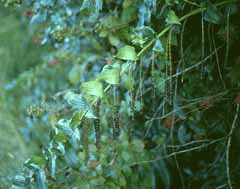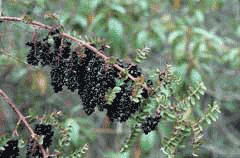 |
|
http://commons.wikimedia.org/wiki/User:Franz_Xaver |
 |
| http://commons.wikimedia.org/wiki/User:Hans_Stieglitz |
Translate this page:
Summary
Physical Characteristics

 Coriaria ruscifolia is a deciduous Shrub growing to 1 m (3ft 3in).
Coriaria ruscifolia is a deciduous Shrub growing to 1 m (3ft 3in).
See above for USDA hardiness. It is hardy to UK zone 8. It is in flower from July to August. The species is hermaphrodite (has both male and female organs).
It can fix Nitrogen.
Suitable for: light (sandy), medium (loamy) and heavy (clay) soils and prefers well-drained soil. Suitable pH: mildly acid, neutral and basic (mildly alkaline) soils. It cannot grow in the shade. It prefers moist soil.
UK Hardiness Map
US Hardiness Map
Synonyms
Plant Habitats
Woodland Garden Sunny Edge; Dappled Shade;
Edible Uses
Edible Parts: Fruit
Edible Uses:
Fruit - raw or used as a beverage[11, 46, 61, 105, 153]. The pressed fruit yields a very palatable juice, which is drunk raw or fermented into wine[2]. Use with great caution since most parts of the plant, including the seed[173], are very toxic and some reports suggest the fruit should not be used at all[11].
References More on Edible Uses
Medicinal Uses
Plants For A Future can not take any responsibility for any adverse effects from the use of plants. Always seek advice from a professional before using a plant medicinally.
None known
References More on Medicinal Uses
The Bookshop: Edible Plant Books
Our Latest books on Perennial Plants For Food Forests and Permaculture Gardens in paperback or digital formats.

Edible Tropical Plants
Food Forest Plants for Hotter Conditions: 250+ Plants For Tropical Food Forests & Permaculture Gardens.
More

Edible Temperate Plants
Plants for Your Food Forest: 500 Plants for Temperate Food Forests & Permaculture Gardens.
More

More Books
PFAF have eight books available in paperback and digital formats. Browse the shop for more information.
Shop Now
Other Uses
Dye
A black ink is obtained from the leaves, it can also be used as a dye[46, 139, 153]. The bark can also be used, it is rich in tannin.
Special Uses
Nitrogen Fixer
References More on Other Uses
Cultivation details
Prefers a fairly good loamy soil in a sunny sheltered position[11, 164, 200. Succeeds in light shade[200]. This species is not very hardy in Britain, it tolerates temperatures down to about -5°c and succeeds outdoors from Sussex and westwards[200]. There is some confusion over the name of this species, some botanists unite this species with the New Zealand C. sarmentosa whilst others maintain that they are distinct[11, 200]. The roots of plants in this genus bear nitrogen-fixing nodules[218]. Whilst much of the nitrogen will be utilized by the growing plant, some of it will become available for other plants growing nearby[K].
References Carbon Farming Information and Carbon Sequestration Information
Temperature Converter
Type a value in the Celsius field to convert the value to Fahrenheit:
Fahrenheit:
The PFAF Bookshop
Plants For A Future have a number of books available in paperback and digital form. Book titles include Edible Plants, Edible Perennials, Edible Trees,Edible Shrubs, Woodland Gardening, and Temperate Food Forest Plants. Our new book is Food Forest Plants For Hotter Conditions (Tropical and Sub-Tropical).
Shop Now
Plant Propagation
Seed - sow February/March in a greenhouse[78]. The seed usually germinates in 1 - 3 months at 15°c[164]. When they are large enough to handle, prick the seedlings out into individual pots and grow them on in the greenhouse for at least their first winter. Plant them out into their permanent positions in late spring or early summer, after the last expected frosts. Cuttings of half-ripe wood, 7cm with a heel, July/August in a frame. Fair percentage[78].
Other Names
If available other names are mentioned here
Native Range
NORTHERN AMERICA: Mexico (Durango, San Luis Potosí, Sinaloa, Chiapas, Colima, Guerrero, Jalisco, México, Michoacán de Ocampo, Morelos, Nayarit, Oaxaca, Puebla) SOUTHERN AMERICA: Guatemala, Panama, Venezuela, Colombia, Ecuador, Peru, Argentina, Chile
Weed Potential
Right plant wrong place. We are currently updating this section.
Please note that a plant may be invasive in one area but may not in your area so it's worth checking.
Conservation Status
IUCN Red List of Threatened Plants Status :

Growth: S = slow M = medium F = fast. Soil: L = light (sandy) M = medium H = heavy (clay). pH: A = acid N = neutral B = basic (alkaline). Shade: F = full shade S = semi-shade N = no shade. Moisture: D = dry M = Moist We = wet Wa = water.
Now available:
Food Forest Plants for Mediterranean Conditions
350+ Perennial Plants For Mediterranean and Drier Food Forests and Permaculture Gardens.
[Paperback and eBook]
This is the third in Plants For A Future's series of plant guides for food forests tailored to
specific climate zones. Following volumes on temperate and tropical ecosystems, this book focuses
on species suited to Mediterranean conditions—regions with hot, dry summers and cool, wet winters,
often facing the added challenge of climate change.
Read More
Expert comment
Author
L.
Botanical References
200
Links / References
For a list of references used on this page please go here
Readers comment